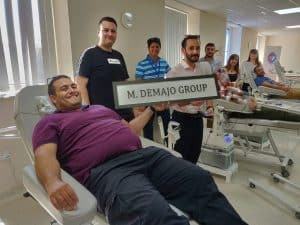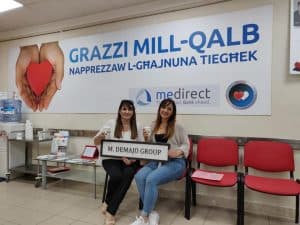According the Red Cross 1 in 4 of us will need a blood transfusion in our lifetime. Yet rates of blood donation are low, with only 10% of those who can give blood donate.
As part of the Demajo Group, a blood donation event was organised by NewTech where employees from all over the group convened at NewTech in Marsa taking donors to and from Iċ-ċentru ta’ l-Għotja tad-demm, G’Mangia.
Refreshments were served throughout the entire event at NewTech HQ.
What is Haemoglobin?
Haemoglobin is a protein in your body that contains iron and gives blood its red color. Hemoglobin is responsible for carrying oxygen from your lungs to nourish all of the tissues in your body.
1 in 4 of us will need a blood transfusion
What is Iron?
Iron is a part of hemoglobin and an essential mineral found in foods we eat. Iron helps your body make new red blood cells, and can help to replace those lost through blood donations.
Is it possible to have normal haemoglobin but low iron?
Yes. This is because in early iron deficiency there is often enough iron circulating in your red cells to keep your Hb level normal.
How is Blood Used?
Red Cell Uses
In the body red blood cells are essential to carry oxygen to all cells in all your tissues and organs. Red cell depletion occurs for any of the following scenarios:
- Red cells are lost from bleeding after injury or during surgery.
- The body loses the capacity to make enough of its own red cells.
- A genetic condition prevents proper red cell formation by the body.
- The body loses the ability to produce enough of its own red blood cells when undergoing chemotherapy for cancer.

Platelet Uses
As part of the blood transfusion process we separate out the platelets. These are very small cells that are essential for blood clotting. Platelets are used in the following scenarios:
- Patients who receive chemotherapy for cancer may need platelet transfusions to help their blood clot effectively.
- Heart surgery patients and victims of serious trauma can need platelet transfusions too.
Platelets have a short shelf life of five days. So keeping the supply going is a constant challenge.
Blood Plasma Uses
The third component of each blood donation is the plasma. This is the fluid in which the cells are suspended in the bloodstream. You have about three litres of it circulating through your blood vessels. It has proteins necessary for immunity and for blood clotting. Plasma can be stored frozen. Plasma is used in the following circumstances:
- Replace proteins where they are lost due to a large blood loss from trauma and during surgery.
- Plasma is used to make purified concentrates. For example patients often receive treatment with immunoglobulin concentrates or albumin made from plasma.
What are the effects of low iron levels?
The main adverse effect of blood donation is iron loss*, so blood donors can benefit from taking an iron supplement if they are unable to replenish their iron stores through diet alone. Donating blood removes iron from your body which is needed to help maintain strength and energy. The American Red Cross encourages all blood and platelet donors to learn how to maintain healthy iron levels and how blood donation impacts the level of iron in your body.


